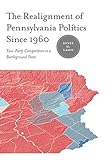The Realignment of Pennsylvania Politics Since 1960 : Two-Party Competition in a Battleground State / Renée M. Lamis.
Material type: TextPublisher: University Park, PA : Penn State University Press, [2021]Copyright date: ©2008Description: 1 online resource (432 p.) : 29 mapsContent type:
TextPublisher: University Park, PA : Penn State University Press, [2021]Copyright date: ©2008Description: 1 online resource (432 p.) : 29 mapsContent type: - 9780271085777
- 320.9748 22
- online - DeGruyter
| Item type | Current library | Call number | URL | Status | Notes | Barcode | |
|---|---|---|---|---|---|---|---|
 eBook
eBook
|
Biblioteca "Angelicum" Pont. Univ. S.Tommaso d'Aquino Nuvola online | online - DeGruyter (Browse shelf(Opens below)) | Online access | Not for loan (Accesso limitato) | Accesso per gli utenti autorizzati / Access for authorized users | (dgr)9780271085777 |
restricted access online access with authorization star
http://purl.org/coar/access_right/c_16ec
The political party system in the United States has periodically undergone major realignments at various critical junctures in the country's history. The Civil War boosted the Republican Party's fortunes and catapulted it into majority status at the national level, a status that was further solidified during the Populist realignment in the 1890s. Starting in the 1930s, however, Roosevelt's New Deal reversed the parties' fortunes, bringing the Democratic Party back to national power, and this realignment was further modified by the "culture wars" beginning in the mid-1960s. Each of these realignments occasioned shifts in the electorate's support for the major parties, and they were superimposed on each other in a way that did not negate entirely the consequences of the preceding realignments. The story of realignment is further complicated by the variations that occurred within individual states whose own particular political legacies, circumstances, and personalities resulted in modulations and modifications of the patterns playing out at the national level. In this book, Renée Lamis investigates how Pennsylvania experienced this series of realignments, with special attention to the period since 1960. She uses a wealth of data from a wide variety of sources to produce an analysis that allows her to trace the evolution of electoral behavior in the Keystone State in a narrative that is accessible to a broad range of readers. Her account helps explain why Senator Arlen Specter was reelected whereas Senator Rick Santorum was not, and why Pennsylvania Republicans have been highly successful in major statewide elections in an era when Democratic presidential standard-bearers have regularly carried the state. Overall, her book constitutes a gold mine of information and interpretation for political junkies as well as scholars who want to know more about how national-level politics plays out within individual states.
Mode of access: Internet via World Wide Web.
In English.
Description based on online resource; title from PDF title page (publisher's Web site, viewed 24. Mai 2022)


